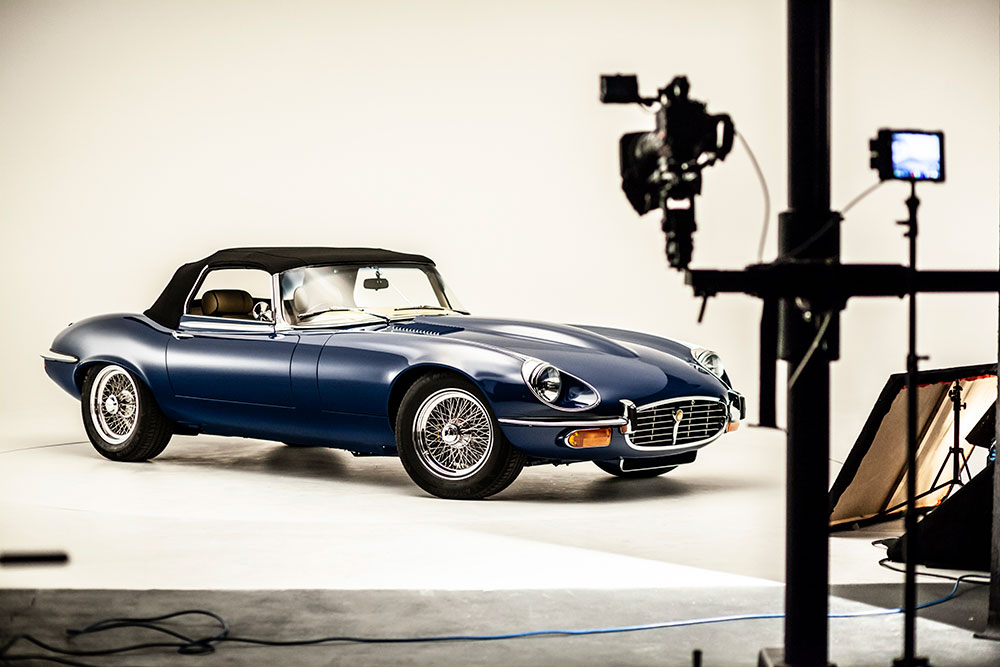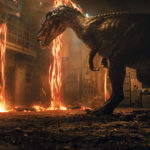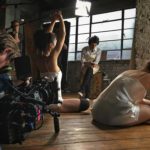
Mixing Cars & Music Stars
Posted on Oct 5, 2018 by Julian Mitchell
CONTENT SPONSORED BY FUJINON

Gun Hill Studios, set amongst the rolling hills of East Sussex, has been custom designed from the ground up to offer a mouthwatering selection of facilities for both car and commercial specialists
If you’ve worn yourself out on a mission to find a shooting space that offers the facilities you need, sometimes the only solution is to create something from scratch yourself. That was the conundrum facing photographer and filmmaker Rupert Cobb, as he struggled to locate a studio within striking distance of home that had the space and height for cars to drive in and be lit in the way he wanted.
Eventually Rupert gave up his lonely search and set about finding a location where he could create a space that ideally suited his situation. The result is Gun Hill Studios in East Sussex, designed around a wish list that would put right all of the shortcomings that had been experienced in other venues.

“We wanted a place that was big enough to accommodate all of the jobs we were likely to take on,” says Rupert. “There had to be the facility for cars to be driven in, of course, and then we put in a massive infinity cove that’s 10mx10mx5m, with an adjacent blackout studio space that’s the same floor size. Both spaces feature a turntable, so the cars can be moved around and filmed while turning if required.
“We also ensured there was enough space behind the set for the most demanding lenses, along with 24K of DMX-controlled motorised downlight augmented with an extensive selection of Arri lights. Although many other light sources are available we are still big fans of tungsten light and the rich colour spectrum it brings, and it does, of course, mean that the studio is equally able for both photographic and filming projects.”

Naturally a space such as this encourages car manufacturers, dealers and owners to book filming and photographic sessions with Rupert and his team, and there have regularly been the likes of Ferraris, McLarens, Rolls Royces and Aston Martins turning up for a spin on the turntables. However, Rupert also has another major string to his bow, one that the giant cove has also proved itself to be equally useful for.
“My background is that I have a long history in music,” says Rupert, “playing trumpet with artists such as Mike and The Mechanics, Bad Manners, Bono, Arthur Brown and so on, as well as co-mixing the revolutionary Series One and Two of Live From Abbey Road, an internally financed performance/documentary series that was filmed at the legendary studio aired worldwide from Channel 4 to Sundance and mixed at our facilities down in Sussex.

“When we moved to our own custom-designed premises I wanted to be able to bring that sensibility to the cove, and this led us to redesign our white turntable so that it had its own mains power supply. This meant that a band could play and be rotated with no lead required, enabling the smoothest of dolly shots and Matrix-style freeze frames. It also means that, when we’re green screening a band or car, they can be moved while the camera stays fixed within the green screen area.”
Alongside the filming, Gun Hill Studios also undertakes multi-track recording with Pro Tools and Presonus flying faders. “We like to be able to morph to whatever a shoot needs,” says Rupert. “So it could be award-winning cars one day and legendary bands another. For example, we’ve just shot all the videos for Paul Carrack’s new album in this space, while we’re constantly having rare cars turning up to be photographed and filmed within our facility. Our latest shoot in the cove features a band that’s a brilliant new signing to Marshall Records, Elswhere, and their single This One’s for You.”

And there is one final advantage to that cove that, while perhaps not initially foreseen, has totally delighted Rupert: “We’ve discovered that the sound in the cove is stunning. The big space without any hard angles makes for excellent live sound quality, so it’s been great to record many bands live in a performance video.”
Using the space
One of the challenges of running a big space such as this is that the overheads are understandably going to be high and so it’s crucial that the studio is fully utilised on a regular basis. Often it will be personal projects designed to highlight the versatility and quality of the brand that will be set up there, but an exciting recent development has seen Gun Hill Studios working on a show entitled Drive-In Music.

“It’s an original and ground-breaking hybrid show,” says Rupert, “that combines two of man’s greatest passions, namely motors and music. The show is set in a drive-in and the charge for parking is a performance in the cove. Breaking artists mingle with unusual vehicles and speak candidly about what drives their creativity and passion.”
The fast moving nature of the production relies on camera set-ups that are ergonomic and easy to handle. After a long search Rupert settled on the Panasonic AU-EVA1, which is used alongside a Panasonic VariCam LT, and he’s been delighted with the performance the camera has offered him and his team.
“For the price – around £6000/$7345 – it’s incredibly well specified,” he says. “It offers a robust and wide codec range, and features a 5.7K Super 35mm sized sensor that can capture up to 14-stops of latitude and delivers Dual Native ISOs of 800 and 2,500, which allows you to film in just about any lighting environment. What I really like about it, however, is its footprint, which is really small, and that helps a lot. For example, if I’m trying to look inside a car to get a close up of the steering wheel then it’s compact enough to enable me to do that.”

The filming of Drive-In Music is usually carried out using three cameras, either
three EVA1s or possibly two EVA1s and a VariCam LT. “We like to shoot with two cameras that are fitted with primes and one that’s partnered with a zoom,” says Rupert. “Every episode of this series is being shot like a movie with no presenter between the audience and the talent, and we often need the flexibility of a zoom so that we’re ready to re-frame quickly to grab those impromptu special moments.”
Until recently the specialist cinema zooms available have been ultra-expensive, to the point where, for many, they would have been purely rental items. However, things have moved on over the past few years, and with the mushrooming of interest in filmmaking manufacturers have responded by delivering new optics that have a more achievable price point.
Fujifilm, for example, has delivered a matched pair of MK cinematic zooms that collectively cover the zoom range of 18-135mm, and for a combined price of around £7000/$8000, which is massively below what a dedicated lens of this type would once have cost. However there are also other Fujifilm cinema zooms that have recently joined the range, one of the most intriguing being the XK6x20 20-120mm T3.5 Cabrio.

Whilst commanding a price of around £13,500/$13,500, this optic still costs considerably less than some of its closest rivals, and it comes with an impressive feature set that includes a detachable servo drive that can be removed to accept industry standard cine motors and matte boxes. There is also LDS and /i metadata compatibility if you want to record the position information of zoom, iris and focus for computer animation and other uses.
In terms of size, the lens is 114 × 226 mm, making it just a tiny bit larger than
the Cabrio 19-90mm (114 x 223 mm), while its weight is 2.9kg, or 2.4kg with the servo unit removed. By using an EOS adaptor Rupert was able to match it with his Panasonic cameras to create a set up that was both nimble yet capable of stunning image quality.
“It was really interesting to try this combination out,” says Rupert. “The XK6x20 worked exceptionally well with both the VariCam LT and the EVA1. It’s very smooth to operate and delivers really sharp footage, while its 20-120mm zoom range is extremely useful and practical. The Motordrive worked really well when the lens was paired with the VariCam and we’re looking forward to now testing this out in earnest with the EVA1, and to do this we’ll need to come up with a compact power solution.”

Focused on Cars
One of the sequences to be filmed for ‘Drive in Music’ featured a very special car, no less than Donald Campbell’s AC Aceca prototype, a three-year restoration job by the Jim Stokes Workshop, and again this involved the EVA1 and XK6x20 20-120mm T3 Cabrio combo being put to the test. It was a challenge passed with aplomb.
“We shoot all the full car sequences with this set up,” says Rupert, “recording the footage at 5.7K Raw on the Eva1 direct to the Atomos Shogun Inferno HDR monitor/recorder using the recorder’s 6G SDI connections.” The Shogun Inferno is also capable of supercharging the EVA1’s slow motion performance, since it can record the Raw output at up to 240fps direct to Apple ProRes or Avid DNxHR. Needless to say the results were stunning, and the outfit has thoroughly endeared itself to the whole team at Gun Hill Studios.

“Everyone here is a stills photographer as well as a filmmaker,” says Rupert, “and being able to test all sorts of lenses in this studio environment is an absolute treat. Added to that I’ve always liked the footage that those with a photographic background are capable of outputting, and I’ve found that skills learned in one discipline give you a good grounding in the other.
“I’m also a big fan of prime lenses for filming work, but there is no doubt that zooms such as the Fujinon XK6x20 20-120mm T3.5 Cabrio are indispensable on those shoots where you have to be able to adapt quickly when there’s no time to change lenses. It’s great that the quality of optics such as these, mean that there’s little sacrifice and much gain in being ready for that instant interview with the owner of the £20 million Ferrari or an opportunity to film a 360˚ shot of a set on the cove with all the flexibility offered by a stunningly sharp 20X zoom.”









